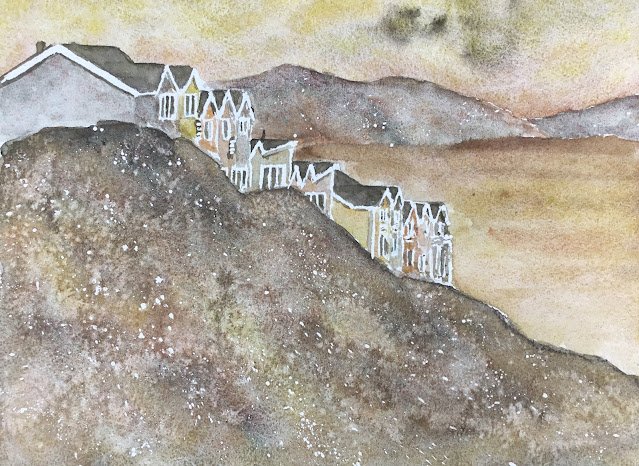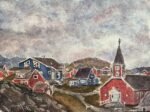It was part 2 of the challenge today. After painting a rocky scene with the tundra supergranulators yesterday, I wanted to paint an Arctic scene with the desert supergranulators today. As is my forte, I headed to Nuuk, the capital of Greenland. My source photo had a blue sky, a blue sea and lots of brightly coloured houses but I restricted myself to the five desert colours (desert grey/green/brown/orange/yellow) to up the ante. The big benefit of this was that if I couldn’t replicate the colours in front of me, I’d have to both think more about colours and values and be inventive. And I was interested in finding out whether restricting the colours in this way would turn the painting into a desert landscape.
Because the houses were absolutely critical to the painting, I used a grid and some accurate measurements to get them right. I followed up by masking out all the whites, giving me a huge safety net and allowing me to go wild with the colours, knowing that there was a decent image underneath them, waiting to emerge at the end. I also added some masking fluid spatters, being careful to use a paper mask to restrict them to the foreground and background hills.
Before applying any paint. I came up with a rough value plan in my head, making the roofs and the top of the foreground hill the darkest spots and the houses and the big triangle shape on the right the lightest. At the same time, I came up with a plan for what colours to use where. I’m pleased to say I managed to stick to both of these plans.
So for the sky, I mainly used the yellow with a bit of orange and brown near the horizon and some grey for a bit of cloud. It came out in an acceptable state, maybe if anything a bit darker than I was looking for.
Then it was on to the distant islands and the sea. I decided that I’d work from back to front with green, then brown, then orange, then yellow to create a bit of depth by warming up colours as I got closer to the viewer. I didn’t use these as pure colours, instead dropping a little of the other colours in to keep this interesting while still using that ordering for the dominant colours. I tried to add reflections of the islands in the sea success, so islands in the sea became sandy dunes in a desert.
The houses were the stage I found most interesting. I’d already decided that the roofs and window panes were going to be dark, so I applied three layers of desert grey, dropping in some wet into wet grey into grey in an attempt to keep things interesting. For the brightly coloured houses, I translated green into desert green, yellow into desert yellow, orange into desert orange and blue into desert green. There were two different blues in the source photo, sanforisiere one of those blues I dropped a bit of desert yellow into the desert green. Once the houses were dry, I used desert grey to add shadows in a few places, under the roof edges in particular.
And then for the near hillside, I wet the whole area then dropped in all five colours wherever I fancied them but with a vague plan to use the darker green and grey along the top edge and to use yellow in all the brightest places on the source photo. While this was drying I decided there wasn’t enough pigment on the paper, so added more paint, still following the plan of semi randomness. And I threw in some salt but tried to use more salt in some places and less in others. And that was me done.
And after rubbing off all the salt and masking fluid I’m left with an interesting painting. It’s Nuuk but it’s not Nuuk. Because the snow has been replaced with sand and all the bright colours have faded in the sun. It’s pretty well exactly what I was hoping to get. It’s interesting to do some temperature comparisons between different paintings:
The rocky scene on the left on desert colours feels warmest and. The Arctic scene in tundra colours on the right the coolest. But the two in between, the rocky scene. In tundra colours and the Arctic scene in desert colours, feel similar in temperature. Interesting.
So, yeah, a success this one, in terms of the painting I ended up with as well as well as discover8ng new ideas through experimentation. This one’s up for sale.
To see the price, click here.










Leave a Reply